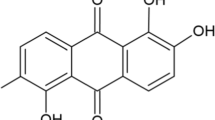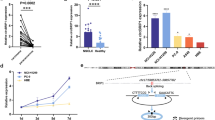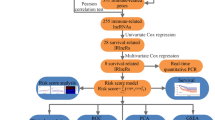Abstract
Colorectal cancer (CRC), one of the most malignant cancers, is currently the fourth leading cause of cancer deaths worldwide. Recent studies indicated that long non-coding RNAs (lncRNAs) could be robust molecular prognostic biomarkers that can refine the conventional tumor-node-metastasis staging system to predict the outcomes of CRC patients. In this study, the lncRNA expression profiles were analyzed in five datasets (GSE24549, GSE24550, GSE35834, GSE50421, and GSE31737) by probe set reannotation and an lncRNA classification pipeline. Twenty-five lncRNAs were differentially expressed between CRC tissue and tumor-adjacent normal tissue samples. In these 25 lncRNAs, patients with higher expression of LINC01296, LINC00152, and FIRRE showed significantly better overall survival than those with lower expression (P < 0.05), suggesting that these lncRNAs might be associated with prognosis. Multivariate analysis indicated that LINC01296 overexpression was an independent predictor for patients’ prognosis in the test datasets (GSE24549, GSE24550) (P = 0.001) and an independent validation series (GSE39582) (P = 0.027). Our results suggest that LINC01296 could be a novel prognosis biomarker for the diagnosis of CRC.



Similar content being viewed by others
References
Kim ER, Kim Y. Clinical application of genetics in management of colorectal cancer. Intestinal Res. 2014;12:184.
Siegel R, Naishadham D, Jemal A. Cancer statistics, 2013. CA Cancer J Clin. 2013;63:11–30.
Sung JJY, Ng SC, Chan FKL, Chiu HM, Kim HS, Matsuda T, et al. An updated Asia Pacific Consensus Recommendations on colorectal cancer screening. Gut. 2014
Zheng ZX, Zheng RS, Zhang SW, Chen WQ. Colorectal cancer incidence and mortality in China, 2010. Asian Pac J Cancer Prev. 2014;15:8455–60.
Ng S, Dong Y, Yu J. MicroRNA dysregulation as a prognostic biomarker in colorectal cancer. Cancer Manag Res. 2014;6:405.
Reimers MS, Zeestraten ECM, Kuppen PJK, Liefers GJ, van de Velde CJH. Biomarkers in precision therapy in colorectal cancer. Gastroenterol Rep. 2013;1:166–83.
Boland CR, Thibodeau SN, Hamilton SR, Sidransky D, Eshleman JR, Burt RW, et al. A National Cancer Institute workshop on microsatellite instability for cancer detection and familial predisposition: development of international criteria for the determination of microsatellite instability in colorectal cancer. Cancer Res. 1998;58:5248–57.
Goldstein J, Tran B, Ensor J, Gibbs P, Wong HL, Wong SF, et al. Multicenter retrospective analysis of metastatic colorectal cancer (CRC) with high-level microsatellite instability (MSI-H). Ann Oncol. 2014;25:1032–8.
Djebali S, Davis CA, Merkel A, Dobin A, Lassmann T, Mortazavi A, et al. Landscape of transcription in human cells. Nature. 2012;489:101–8.
Kornienko AE, Guenzl PM, Barlow DP, Pauler FM. Gene regulation by the act of long non-coding RNA transcription. BMC Biol. 2013;11:59.
Derrien T, Johnson R, Bussotti G, Tanzer A, Djebali S, Tilgner H, et al. The GENCODE v7 catalog of human long noncoding RNAs: analysis of their gene structure, evolution, and expression. Genome Res. 2012;22:1775–89.
Yang G, Lu X, Yuan L. LncRNA: a link between RNA and cancer. Biochim Biophys Acta (BBA) Gene Regul Mech. 2014;1839:1097–109.
Zhang X, Sun S, Pu JKS, Tsang ACO, Lee D, Man VOY, et al. Long non-coding RNA expression profiles predict clinical phenotypes in glioma. 2012;48:1–8.
Zhou Y, Zhong Y, Wang Y, Zhang X, Batista DL, Gejman R, et al. Activation of p53 by MEG3 non-coding RNA. J Biol Chem. 2007;282:24731–42.
Barsyte-Lovejoy D. The c-Myc oncogene directly induces the h19 noncoding RNA by allele-specific binding to potentiate tumorigenesis. Cancer Res. 2006;66:5330–7.
Wang Y, Jatkoe T, Zhang Y, Mutch MG, Talantov D, Jiang J, et al. Gene expression profiles and molecular markers to predict recurrence of dukes’ b colon cancer. J Clin Oncol. 2004;22:1564–71.
Kim H, Lee D, Yim G, Nam E, Kim S, Kim S, et al. Long non-coding RNA HOTAIR is associated with human cervical cancer progression. Int J Oncol. 2014
Gupta RA, Shah N, Wang KC, Kim J, Horlings HM, Wong DJ, et al. Long non-coding RNA HOTAIR reprograms chromatin state to promote cancer metastasis. Nature. 2010;464:1071–6.
Loo LWM, Cheng I, Tiirikainen M, Lum-Jones A, Seifried A, Dunklee LM, et al. Cis-expression QTL analysis of established colorectal cancer risk variants in colon tumors and adjacent normal tissue. PLoS One. 2012;7:e30477.
Sveen A, Ågesen TH, Nesbakken A, Rognum TO, Lothe RA, Skotheim RI. Transcriptome instability in colorectal cancer identified by exon microarray analyses: associations with splicing factor expression levels and patient survival. Genome Med. 2011;3:32.
Pizzini S, Bisognin A, Mandruzzato S, Biasiolo M, Facciolli A, Perilli L, et al. Impact of microRNAs on regulatory networks and pathways in human colorectal carcinogenesis and development of metastasis. BMC Genom. 2013;14:589.
Aziz MA, Periyasamy S, Al YZ, AlAbdulkarim I, Al OM, Alfahed A, et al. Integrated exon level expression analysis of driver genes explain their role in colorectal cancer. PLoS One. 2014;9:e110134.
Yang J, Lin J, Liu T, Chen T, Pan S, Huang W, et al. Analysis of lncRNA expression profiles in non-small cell lung cancers (NSCLC) and their clinical subtypes. Lung Cancer. 2014;85:110–5.
Yang F, Zhang L, Huo X, Yuan J, Xu D, Yuan S, et al. Long noncoding RNA high expression in hepatocellular carcinoma facilitates tumor growth through enhancer of zeste homolog 2 in humans. Hepatology. 2011;54:1679–89.
Emig D, Salomonis N, Baumbach J, Lengauer T, Conklin BR, Albrecht M. AltAnalyze and DomainGraph: analyzing and visualizing exon expression data. Nucleic Acids Res. 2010;38:W755–62.
Smyth GK. Limma: linear models for microarray data. In: Gentleman R, Carey V, Dudoit S, Irizarry R, Huber W, editors. Bioinformatics and computational biology solutions using {R} and bioconductor. New York: Springer; 2005. p. 397–420.
Eisen MB, Spellman PT, Brown PO, Botstein D. Cluster analysis and display of genome-wide expression patterns. Proc Natl Acad Sci. 1998;95:14863–8.
Stacklies W, Redestig H, Scholz M, Walther D, Selbig J. PcaMethods a bioconductor package providing PCA methods for incomplete data. 2007;23:1164–1167.
Marisa L, de Reynies A, Duval A, Selves J, Gaub MP, Vescovo L, et al. Gene expression classification of colon cancer into molecular subtypes: characterization, validation, and prognostic value. PLoS Med. 2013;10:e1001453.
Ge X, Chen Y, Liao X, Liu D, Li F, Ruan, H, et al. Overexpression of long noncoding RNA PCAT-1 is a novel biomarker of poor prognosis in patients with colorectal cancer. Med Oncol. 2013;30.
Kodera Y, Yamamura Y, Shimizu Y, Torii A, Hirai T, Yasui K, et al. Peritoneal washing cytology: prognostic value of positive findings in patients with gastric carcinoma undergoing a potentially curative resection. J Surg Oncol. 1999;72:60–4.
Cunningham D, Atkin W, Lenz HJ, Lynch HT, Minsky B, Nordlinger B, et al. Colorectal cancer. Lancet. 2010;375:1030–47.
Dong Y, Wu WKK, Wu CW, Sung JJY, Yu J, Ng SSM. MicroRNA dysregulation in colorectal cancer: a clinical perspective. Brit J Cancer. 2011;104:893–8.
Yin D, He X, Zhang E, Kong R, De W, Zhang Z. Long noncoding RNA GAS5 affects cell proliferation and predicts a poor prognosis in patients with colorectal cancer. Med Oncol. 2014;31:253.
Peng W, Gao W, Feng J. Long noncoding RNA HULC is a novel biomarker of poor prognosis in patients with pancreatic cancer. Med Oncol. 2014;31:346.
Pang EJ, Yang R, Fu XB, Liu YF. Overexpression of long non-coding RNA MALAT1 is correlated with clinical progression and unfavorable prognosis in pancreatic cancer. Tumour Biol. 2014
Hu Y, Chen HY, Yu CY, Xu J, Wang JL, Qian J, et al. A long non-coding RNA signature to improve prognosis prediction of colorectal cancer. Oncotarget. 2014;5:2230–42.
Li L, Sun R, Liang Y, Pan X, Li Z, Bai P, et al. Association between polymorphisms in long non-coding RNA PRNCR1 in 8q24 and risk of colorectal cancer. J Exp Clin Cancer Res. 2013;32:104.
Qi P, Xu MD, Ni SJ, Shen XH, Wei P, Huang D, et al. Down-regulation of ncRAN, a long non-coding RNA, contributes to colorectal cancer cell migration and invasion and predicts poor overall survival for colorectal cancer patients. Mol Carcinog. 2014.
Zheng HT, Shi DB, Wang YW, Li XX, Xu Y, Tripathi P, et al. High expression of lncRNA MALAT1 suggests a biomarker of poor prognosis in colorectal cancer. Int J Clin Exp Pathol. 2014;7:3174–81.
Svoboda M, Slyskova J, Schneiderova M, Makovicky P, Bielik L, Levy M, et al. HOTAIR long non-coding RNA is a negative prognostic factor not only in primary tumors, but also in the blood of colorectal cancer patients. Carcinogenesis. 2014;35:1510–5.
Shi D, Zheng H, Zhuo C, Peng J, Li D, Xu Y, et al. Low expression of novel lncRNA RP11-462C24.1 suggests a biomarker of poor prognosis in colorectal cancer. Med Oncol. 2014;31:31.
Ge X, Chen Y, Liao X, Liu D, Li F, Ruan H, et al. Overexpression of long noncoding RNA PCAT-1 is a novel biomarker of poor prognosis in patients with colorectal cancer. Med Oncol. 2013;30:588.
He X, Tan X, Wang X, Jin H, Liu L, Ma L, et al. C-Myc-activated long noncoding RNA CCAT1 promotes colon cancer cell proliferation and invasion. Tumour Biol. 2014;35:12181–8.
Graham LD, Pedersen SK, Brown GS, Ho T, Kassir Z, Moynihan AT, et al. Colorectal neoplasia differentially expressed (CRNDE), a novel gene with elevated expression in colorectal adenomas and adenocarcinomas. Genes Cancer. 2012;2:829–40.
Han Y, Yang YN, Yuan HH, Zhang TT, Sui H, Wei XL, et al. UCA1, a long non-coding RNA up-regulated in colorectal cancer influences cell proliferation, apoptosis and cell cycle distribution. Pathology. 2014;46:396–401.
Kam Y, Rubinstein A, Naik S, Djavsarov I, Halle D, Ariel I, et al. Detection of a long non-coding RNA (CCAT1) in living cells and human adenocarcinoma of colon tissues using FIT-PNA molecular beacons. Cancer Lett. 2014;352:90–6.
Tian F, Tang Z, Song G, Pan Y, He B, Bao Q, et al. Loss of imprinting of IGF2 correlates with hypomethylation of the H19 differentially methylated region in the tumor tissue of colorectal cancer patients. Mol Med Rep. 2012;5:1536–40.
Neumann O, Kesselmeier M, Geffers R, Pellegrino R, Radlwimmer B, Hoffmann K, et al. Methylome analysis and integrative profiling of human HCCs identify novel protumorigenic factors. Hepatology. 2012;56:1817–27.
Zhang EB, Kong R, Yin DD, You LH, Sun M, Han L, et al. Long noncoding RNA ANRIL indicates a poor prognosis of gastric cancer and promotes tumor growth by epigenetically silencing of miR-99a/miR-449a. Oncotarget. 2014;5:2276–92.
Acknowledgments
This work was supported by grants from the National Basic Research Project of China (2010CB529502 and 2007CB511904), National Natural Science Foundation of China (81471485), and the Key Program for the Fundamental Research of the Science and Technology Commission of Shanghai (11JC1411000).
Conflicts of interest
None
Author information
Authors and Affiliations
Corresponding author
Electronic supplementary material
Below is the link to the electronic supplementary material.
Fig. S1
Validation of 45 differentially expressed lncRNAs using an independent dataset (GSE50421). In HCA (A), the x axis represents the samples, and lncRNAs are shown on the y axis. Red spots represent upregulated genes, and green spots represent downregulated genes. The sample types are shown with bar colors in the dendrogram; blue stripes represent tumor-adjacent normal samples, and red stripes are tumor samples. In PCA (B), green dots represent tumor-adjacent normal tissue samples, and red dots represent tumor tissue samples. In GSE50421, CRC samples can be distinguished from tumor-adjacent normal tissues by HCA and PCA (GIF 51 kb)
Fig. S2
Validation of 38 differentially expressed lncRNAs using an independent dataset (GSE35834). In HCA (A), the x axis represents the samples, and lncRNAs are shown on the y axis. Red spots represent upregulated genes, and green spots represent downregulated genes. The sample types are shown with bar colors in the dendrogram; blue stripes represent tumor-adjacent normal samples, and red stripes are tumor samples. In PCA (B), green dots represent tumor-adjacent normal tissue samples, and red dots represent tumor tissue samples. In GSE35834, CRC samples can be distinguished from tumor-adjacent normal tissues by HCA and PCA (GIF 48 kb)
Fig. S3
Validation of 48 differentially expressed lncRNAs using an independent dataset (GSE24549). In HCA (A), the x axis represents the samples, and lncRNAs are shown on the y axis. Red spots represent upregulated genes, and green spots represent downregulated genes. The sample types are shown with bar colors in the dendrogram; blue stripes represent tumor-adjacent normal samples, and red stripes are tumor samples. In PCA (B), green dots represent tumor-adjacent normal tissue samples, and red dots represent tumor tissue samples. In GSE24549, CRC samples can be distinguished from tumor-adjacent normal tissues by HCA and PCA (GIF 67 kb)
Fig. S4
Validation of 45 differentially expressed lncRNAs using an independent dataset (GSE24550). In HCA (A), the x axis represents the samples, and lncRNAs are shown on the y axis. Red spots represent upregulated genes, and green spots represent downregulated genes. The sample types are shown with bar colors in the dendrogram; blue stripes represent tumor-adjacent normal samples, and red stripes are tumor samples. In PCA (B), green dots represent tumor-adjacent normal tissue samples, and red dots represent tumor tissue samples. In GSE24550, CRC samples can be distinguished from tumor-adjacent normal tissues by HCA and PCA (GIF 61 kb)
ESM 5
(DOC 28 kb)
ESM 6
(DOC 13 kb)
ESM 7
(DOC 73 kb)
Rights and permissions
About this article
Cite this article
Qiu, Jj., Yan, Jb. Long non-coding RNA LINC01296 is a potential prognostic biomarker in patients with colorectal cancer. Tumor Biol. 36, 7175–7183 (2015). https://doi.org/10.1007/s13277-015-3448-5
Received:
Accepted:
Published:
Issue Date:
DOI: https://doi.org/10.1007/s13277-015-3448-5




